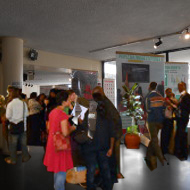 Three architecture exhibitions were on display at the Nairobi Alliance Francaise on Loita Street from 05 June until 07 July. The exhibition opening on 05 June also saw the launch of Dr Lydia Muthuma’s book, ‘Nairobi in Pictures (1899-2000)’ which was accompanied by photographs of 100 Nairobi buildings and a number of historic settlement photos. The book and photographs, seek to establish a link between Nairobi’s buildings and its people by cataloging the city’s transformation, and identifying elements of culture that make the city what it is. The second exhibition, ‘Architecture=Durable’ showed 10 recent projects by 10 French architects over time.
Three architecture exhibitions were on display at the Nairobi Alliance Francaise on Loita Street from 05 June until 07 July. The exhibition opening on 05 June also saw the launch of Dr Lydia Muthuma’s book, ‘Nairobi in Pictures (1899-2000)’ which was accompanied by photographs of 100 Nairobi buildings and a number of historic settlement photos. The book and photographs, seek to establish a link between Nairobi’s buildings and its people by cataloging the city’s transformation, and identifying elements of culture that make the city what it is. The second exhibition, ‘Architecture=Durable’ showed 10 recent projects by 10 French architects over time.
The third exhibition was titled ‘People Building Better Cities: Participation and Inclusive Urbanization‘ (PBBC). PBBC is an exhibition that is traveling around the world highlighting participatory approaches to solving contemporary urban planning challenges. To date it has been shown in Bangkok, Rio de Janeiro, Sydney, Johannesburg and Nairobi. Over the next few months it will be shown in India, China and the USA. The driving force behind the PBBC traveling exhibition is Dr. Anna Rubbo, (Senior Scholar at the Earth Institute Center for Sustainable Urban Development and Global Studio founder). We had a chance to speak with Dr. Rubbo directly, asking her a few questions about her experience of working on the exhibition.
**********************************************************************************************
Nairobi Planning Innovations: How was the exhibition organized in Nairobi and what was the highlight of the Nairobi PBBC exhibition?
Dr. Anna Rubbo: We worked with Professor Alfred Omenya, Dean of Architecture TU-Kenya and the Nairobi Alliance Francaise to organize the showing of PBBC in Nairobi. Former president of the Union of International Architects, Louise Cox, a member of the PBBC Advisory Group, also assisted us in arranging this. A highlight was that we would co-exhibit with others, and we were very pleased to join two other exhibitions that also focused on architecture. The three exhibitions, and the book launch, drew a crowd of around 350 people to the June 5 opening. Opening speakers included the French Ambassador to Kenya, the Sports, Arts and Culture Cabinet Secretary, the Director of the Alliance Francaise, and the Go-Down Centre. It was a very lively evening.
Nairobi Planning Innovations: Who was the exhibition intended for?
Dr. Anna Rubbo: If you look at the PBBC website (http://peoplebuildingbettercities.org/) you’ll see that PBBC aims to reach a broad cross section of people, including students, educators, professionals, communities, policy and decision makers. Being such a centrally located and well-regarded institution, the Alliance Francaise attracts a wide range of visitors. So it was a wonderful venue for us. At the opening there were professionals in the fields of urban planning, architecture, the visual and performing arts, students and people simply passing by who stopped in to see what was happening. It was pleasing to see there was a lot of interest in the PBBC panels, and some very good questions. The following day there were children who attended language classes at the Alliance Francaise taking a close look at PBBC, and this was good to see. I wasn’t in Nairobi long enough to attend the ‘Science Café’ that included a discussion of the exhibition and the Global Studio education program, which is the source of some the PBBC exhibition material. The Science Café is an innovative program by the Alliance Director, and aims to engage an interested public in conversation with experts and lay people on topical issues, exhibitions etc.
Nairobi Planning Innovations: Were there any expected or unexpected connections that came from executing this month long exhibition?
Dr. Anna Rubbo: There were unexpected, perhaps serendipitous, connections amongst the three exhibitions. All three had an urban and an architecture focus. The PBBC exhibit addressed the relationship between poor communities and planning, and ways in which participatory planning and design can mitigate poverty and promote environmental justice. The French exhibition (10 buildings by 10 architects) depicted innovative architectural projects that addressed sustainability and making more livable places, some in the disadvantaged parts of Paris. The photographic exhibit showed 100 of Nairobi’s best buildings in the CBD, and early settlement photos. The latter created a lot of interest and complimented a growing concern about conserving local architecture. I was very pleased to hear that this interest is served by organizations such as the Nairobi Arts GoDown, which is offering walking tours of the city center. Apparently, there are new conversations around historic building preservation going on amongst young architects and urbanists and I understand walking tours will be organized in all the city’s neighborhoods. So, it seems they will also take in the neighborhoods of poor communities as well. As PBBC advocates for urban inclusivity and pro-poor development, this was an exciting initiative to see.
Getting back to your question about unexpected connections. Meeting so many people through the exhibition opened up opportunities. I was pleased to be offered a tour of the central business district. Traveling the city in matatus, getting stuck in traffic, seeing final year architecture projects at the University of Nairobi, visiting UN Habitat, meeting academic colleagues, and having people show me places as diverse as Westlands, Eastlands and Kibera, I felt I understood a little more about this fascinating city than when I arrived.
